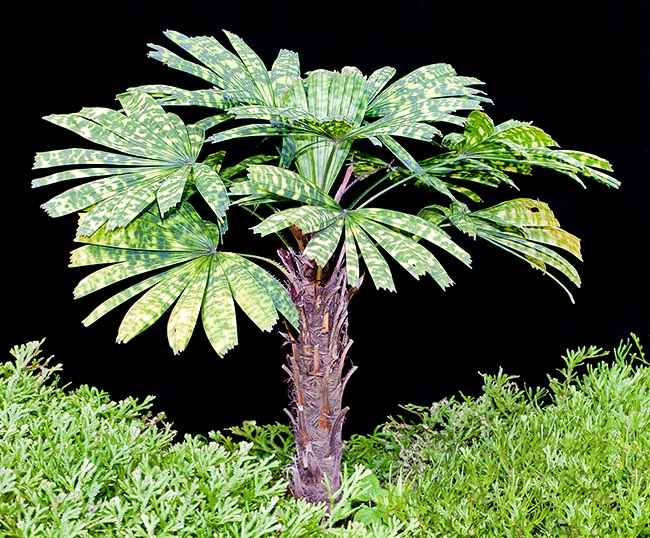Family : Arecaceae

Text © Pietro Puccio

English translation by Mario Beltramini

Licuala mattanensis seldom exceeds the 3 m. Beautiful, even variegated, but difficult to cultivate © G. Mazza
The name of the genus comes from the local name “leko wala”, given to this genus of palm in the Maluku Islands; the name of the species indicates the origin place, the Mattang Mountain in Sarawak.
The Licuala mattanensis Becc. (1889) is a solitary, monoecious, slow growing, species, up to about 3 m tall, in the oldest specimens in the wild, with thin stem covered by the remnants of the foliar petioles.
The leaves are almost round-shaped, divided up to the base, in 8-12 cuneiform segments of variable size, truncated and indented at the apex, long, in the median part, about 40 cm, of a glossy dark green colour.
Short inflorescences among the leaves carrying hermaphrodite flowers; the fruits are fusiform, about 2,5 cm long, of orange yellow colour. It reproduces by seed, which is to be planted as soon as possible as it has a short-lasting ability to germinate; the germination times are fairly variable, fresh seeds may germinate in 2-3 months, at the temperature of 26-30 °C, but may take even much longer times, 6-10 months. The variegated forms, such as the ‘Mapu’ and ‘Tigrina’, are by far the most cultivated of the species, but are more delicate and with a particularly slow growth, have green yellow maculae and are considered as standing among the most ornamental palms, but even among the most difficult to be cultivated at best.
Species and varieties can be cultivated exclusively in humid tropical climate zones, with high and constant temperatures, with daily lowest over the 20 °C, in shaded position and sheltered from the wind, on well drained, acidic, rich of organic substance soils, kept constantly humid. Where the open air cultivation is not possible, it is cultivated in warm greenhouse, in preferably earthenware pot, in soil which may be peat-based with addition of siliceous sand and perlite, for improving the drainage, with high, constant, ambient humidity, 80-90%, and good ventilation; if the humidity is insufficient, the apices easily dry up. For the fertilizations, it is advisable the utilization of balanced, slow-releasing, products; an accumulation of salts at the roots inhibits its growth; for the waterings, the hard water is to be avoided. The repottings are to be done leaving the rootball undamaged as it does not stand dangers to the rooting apparatus.
→ For general notions about ARECACEAE please click here.
